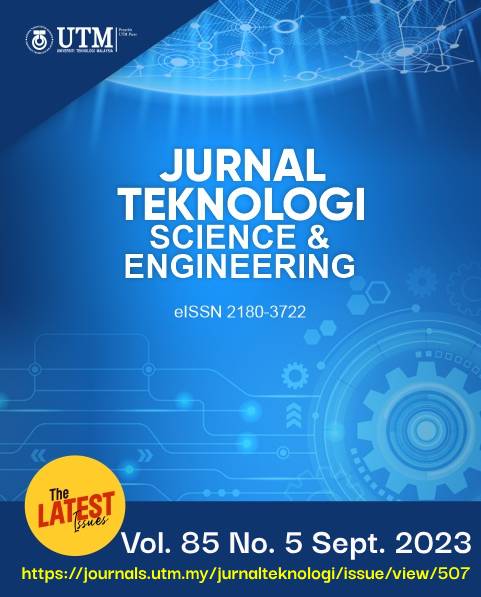DESIGNING THE TECHNOLOGY FOR TURBIDITY SENSOR-BASED AUTOMATIC RIVER SEDIMENTATION MEASUREMENT
DOI:
https://doi.org/10.11113/jurnalteknologi.v85.19618Keywords:
Turbidity sensor, sedimentation, calibration, Arduino sketch, conversionAbstract
Sedimentation measurement has been quite difficult to do as it requires more time for and more activity in water management, thus affects the quality and quantity of obtained data. The purpose of this study was to create a set of devices capable of automatically measuring sediment and flow characteristics. The phases of this research were the determination and assembly of all the device components, creation of a program for converting data into numbers, sampling, and device testing. The results of the device testing, which were obtained from calibration and conversion tests, indicated that the devices had been well tested. The calibration and conversion curves showed the R value was close to 1. As for the unit conversion equation of NTU and ppm, it was y = 11.71x – 1037.2. In conclusion, with the successful creation of this automatic measuring devices, the turbidity and flow velocity-based sedimentation measurement is expected to be the solution to issues demanding efficient and practical data retrieval.
References
Andriyani, I., Wahyuningsih, S., and Karim, M. D. 2019. Prediksi Laju Sedimentasi dan Erosi di Sub DAS Kemuning Menggunakan Rainfall Simulator. agriTECH. 39(3): 179-187.
Arsyad, S. 2006. Konservasi Tanah dan Air. Bogor: Indonesia. Penerbit IPB (IPB Press).
Balai Penelitian Teknologi Kehutanan Pengelolaan Daerah Aliran Sungai. 2014. Teknik Pengukuran Hasil Sedimen. Solo, Indonesia: Kementriaan Lingkungan Hidup.
Omar, A.F., and Matjafri, M.Z. 2009. Turbidimeter Design and Analysis: A Review on Optical Fiber Sensors for the Measurement of Water Turbidity. Sensors Jurnal. 9: 8311-8335.
Noor, A., Supriyanto, A., and Rhomadhona, H. 2019. Aplikasi Pendeteksi Kualitas Air Menggunakan Turbidity Sensor Dan Arduino Berbasis Web Mobile. Jurnal CoreIT. 5(1).
YN, N. H., Suprapto, M., and Suyanto, S. 2013. Kajian Angkutan Sedimen Pada Sungai Bengawan Solo (Serenan-Jurug). Matriks Teknik Sipil. 1(2).
Ariadi, M. M., Sugriwan, I., and Fahrudin, A. E. 2022. Sistem Alat Ukur Kekeruhan Berbasis Mikrokontroler ATMega16A-PU. Jurnal Fisika Flux: Jurnal Ilmiah Fisika FMIPA Universitas Lambung Mangkurat. 1(1): 112-119.
Mulyana, Y., and Hakim, D. L. 2018. Prototype of Water Turbidity Monitoring System. IOP Conference Series: Materials Science and Engineering. 384(1): 012052. IOP Publishing.
Wang, Y., Rajib, S. S. M., Collins, C., and Grieve, B. 2018. Low-cost Turbidity Sensor for Low-power Wireless Monitoring of Fresh-water Courses. IEEE Sensors Journal. 18(11): 4689-4696.
Suliyani, N., Suciyati, S. W., Pauzi, G. A., and Surtono, A. 2021. Rancang Bangun Alat Ukur Kekeruhan Air Menggunakan Fototransistor dan LED Inframerah Berbasis Arduino Uno. Journal of Energy, Material, and Instrumentation Technology. 2(2): 39-47.
Ammari, S., Wildian, W., and Harmadi, H. 2019. Rancang Bangun Sistem Peringatan Dini Banjir Berdasarkan Tingkat Kekeruhan Air Hulu Sungai dengan Turbidity Sensor SEN0189 dan Transceiver nRF24L01+. Jurnal Fisika Unand. 8(3): 240-244.
Yasin, H. M., Zeebaree, S. R., Sadeeq, M. A., Ameen, S. Y., Ibrahim, I. M., Zebari, R. R., and Sallow, A. B. 2021. IoT and ICT based Smart Water Management, Monitoring and Controlling System: A Review. Asian Journal of Research in Computer Science. 8(2): 42-56.
Aprilia, I., and Ariyanti, D. 2021. Rancang Bangun Prototype Alat Pendeteksi Tingkat Kekeruhan dan Mengukur Debit Air pada Kolam Lele Menggunakan Arduino Uno. TESLA: Jurnal Teknik Elektro. 23(1): 58-70.
Chang, V., and Martin, C. 2021. An Industrial IoT Sensor System for High-temperature Measurement. Computers and Electrical Engineering. 95: 107439.
Martinez-Santos, J. C., Acevedo-Patino, O., and Contreras-Ortiz, S. H. (2017). Influence of Arduino on the Development of Advanced Microcontrollers Courses. IEEE revista iberoamericana de tecnologias del aprendizaje. 12(4): 208-217.
Nasution, T. H., Muchtar, M. A., Siregar, I., Andayani, U., Christian, E., and Sinulingga, E. P. 2017. Electrical Appliances Control Prototype by using GSM Module and Arduino. 2017 4th International Conference on Industrial Engineering and Applications (ICIEA). IEEE. 355-358.
Minella, J. P., Merten, G. H., Reichert, J. M., and Clarke, R. T. 2008. Estimating Suspended Sediment Concentrations from Turbidity Measurements and the Calibration Problem. Hydrological Processes: An International Journal. 22(12): 1819-1830.
Kelley, C. D., Krolick, A., Brunner, L., Burklund, A., Kahn, D., Ball, W. P., and Weber-Shirk, M. 2014. An Affordable Open-source Turbidimeter. Sensors. 14(4): 7142-7155.
Nagels, J. W., Davies-Colley, R. J., and Smith, D. G. 2001. A Water Quality Index for Contact Recreation in New Zealand. Water Science and Technology. 43(5): 285-292.
Susfalk, R. B., Fitzgerald, B., and Knust, A. M. 2008. Characterization of Turbidity and Total Suspended Solids in the Upper Carson River, Nevada. DHS Publication.
Downloads
Published
Issue
Section
License
Copyright of articles that appear in Jurnal Teknologi belongs exclusively to Penerbit Universiti Teknologi Malaysia (Penerbit UTM Press). This copyright covers the rights to reproduce the article, including reprints, electronic reproductions, or any other reproductions of similar nature.
















